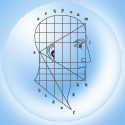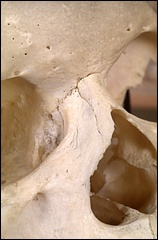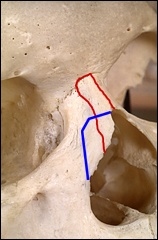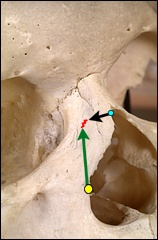
- Incisions

- Hump removal

- Nasal septum

- Tip narrowing

- The nasal bones

- Splint

- Tip support

- Shorten the nose

- The nasal spine

- Revision surgery

- The nasion

- Odd cartilages



|
| Image size: small show larger |
|
On the skull above right, the right nasal bone is outlined in red. You can compare the outline with the thin cracks, the suture lines, that you see on the skull above left. A portion of that nasal bone, however, does not contribute to the excess width of the nose. The part of the nasal bone closest to the forehead doesn't contribute to the width of the nose. Further, part of the adjacent cheekbone does contribute to the nose's excess width in the bony pyramid. For that reason, the piece of bone that is mobilized and moved does not correspond exactly with the anatomic nasal bone. Outlined in blue is the section of bone that does contribute to excess width. The blue outline contains part of the nasal bone and part of the adjacent cheek bone. It is that blue-outlined piece of bone that is freed from the surrounding skull and pushed into its new position during the rhinoplasty. |
| Click on any image in this tutorial to see a greatly-enlarged version |

|
|
Then, the chisel is repositioned within the nostril, and another cut is made along the path of the green arrow. After the chisel has cut to the tip of the green arrow, the chisel is used to gently push the bone inward. The force of that push causes the bone to separate along the jagged red line, sometimes with an audible snap. With the separation along the red line, the bone is completely free to move, and it can be positioned closer to the midline. Compare the paths of the black and green arrows above with the blue outline of the bone that we want to move at the top of this page. |
| Clear all red checks in the Rhinoplasty Tutorial |